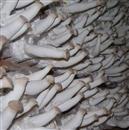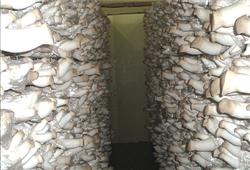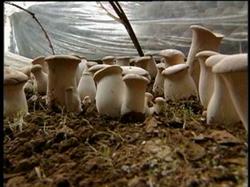Introduction to the characteristics of Pleurotus eryngii

Pleurotus eryngii, also known as Pleurotus ostreatus (Pleurotus eryngi), has almond flavor, and its fleshy meat is similar to that of abalone, so it is named Pleurotus eryngii. In Japan, it is called "snow antler". It is saprophytic and parasitic on the roots and surrounding soil of Erygium campestre, a plant of Umbelliferae from late spring to early summer. It is naturally distributed in Italy, Spain, France, Germany, Czechoslovakia, Hungary, the former southern Soviet Union, Morocco, India, Pakistan, China and western Sichuan. Pleurotus eryngii is rich in nutrition, crisp and tender texture, excellent taste and unique flavor, so it is known as "king of Pleurotus ostreatus" and "delicious boletus on the prairie". Biological characteristics ㈠ mushroom body shape fruiting body is generally medium-sized. Singles or groups. The diameter of the mushroom cover is 2-12cm. At the initial stage, the inner roll of the cover edge is hemispherical, then flattens gradually, and the center is shallow concave and disk-shaped to funnel-shaped after maturity. Light gray when young, light yellowish white after maturity, with radial black-brown fine stripes around the center. The fungus is white with almond flavor. The bacterial folds propagate downward and are dense. The mushroom stalk is characterized by a thick, medium-sized, fleshy, white base. The cultivation is in the shape of a stick to a bowling ball when there is little ventilation. The spores are white or light yellow. Spores subfusiform, smooth. The hyphae have lock-like union. ㈡ fertility condition 1. Nutritious Pleurotus eryngii is a kind of edible fungus with strong ability to decompose lignin and cellulose, which needs rich nutrition, especially sufficient nitrogen source, exuberant mycelium growth and higher yield. The main materials of artificial cultivation grow well on the substrates such as cotton husk, sawdust, bagasse, straw and so on. Substitute cultivation with auxiliary materials, such as rice bran, wheat bran, corn meal, cottonseed cake powder, calcium carbonate, sugar and so on, can promote the growth and spread of mycelium and increase the occurrence of mushroom buds. two。 The water content of Pleurotus eryngii is more drought-tolerant, but the suitable water content is more beneficial to the growth and development and increase the yield. In the mycelial growth stage, the suitable water content of the culture material is 60% Mel 65%, but since it is not suitable to spray water on the mushroom body during cultivation, the water needed for the mushroom body mainly comes from the culture material, so the water content of the culture material can be appropriately increased to 65% Rue 70%. The relative humidity of the air is about 60% in the mycelium growth stage, while 90-95% is suitable in the primordial post-fruiting body differentiation stage, and the fruiting body growth stage can be appropriately reduced to 85-90%. 3. Temperature is the key to determine the success or failure of cultivation and the yield of Pleurotus eryngii. The temperature range of mycelium growth is 22-27 ℃, the optimum temperature is about 25 ℃, which is higher than 30 ℃, and the mycelium growth is poor. Pleurotus eryngii is a kind of constant temperature fruiting mushroom, the temperature difference is too large, which is disadvantageous to the occurrence of primordia. The temperature range of mushroom emergence is 10-18 ℃, the optimum temperature is 12-16 ℃, the primordium will not appear below 8 ℃, and deformed mushrooms are easy to occur above 20 ℃, and diseases will occur, causing dead and rotten mushrooms. The growth temperature of fruiting body is 10-21 ℃, and the optimum temperature is 10-18 ℃. The mastery of temperature varies from strain to strain, so special attention should be paid to the characteristics of the strain during introduction. 4. The oxygen demand in the growth stage of air mycelium is relatively less, and the low concentration of CO can stimulate the growth of mycelium. With the growth of mycelium, the concentration of CO2 in the bag (bottle) gradually increases from 0.03% in normal air to more than 2%, and the mycelium can still grow well. At present, sufficient oxygen is needed in the original base period, and the concentration of CO2 should be reduced to about 0.5%. Otherwise, the primordium does not differentiate and expands into a ball. Fresh air is needed in the period of mushroom growth and development, and the concentration of CO2 should be less than 0.4%. 5. Light mycelium growth stage does not need light, in the dark environment will accelerate mycelium growth. The growth and development of primordia and fruiting bodies need some scattered light, and the suitable light intensity is 500-1000Lx. 6. The pH range of pH value mycelium growth was 4-8, and the optimum pH was 6.5-7.5. The optimum pH value at the stage of mushroom emergence is 5.5-6.5.
- Prev

How can Pleurotus eryngii produce more mushrooms?
The growth temperature of Pleurotus eryngii was 6 ℃ ~ 25 ℃. The growth of mushroom body is slow at 6 ℃ ~ 15 ℃, but the mushroom body has fine tissue and beautiful color, so high quality mushroom can be cultivated. The management of bud stage should strengthen ventilation in order to promote the growth of cap and inhibit the growth of stalk. ...
- Next

Six tips for high yield cultivation of Pleurotus eryngii indoors and outdoors
The body of Pleurotus eryngii is fat and long, with a stout and smooth stalk, 2.5 cm in diameter and 10 cm in length; the lid is 4 cm in diameter, slightly concave in the middle, and the yellow fold is smooth. It is called snow antler because of its snow-white color. Because it contains almond flavor, the Japanese call it mushroom, which is a newly developed rare mushroom in recent years.
Related
- Fuxing push coffee new agricultural production and marketing class: lack of small-scale processing plants
- Jujube rice field leisure farm deep ploughing Yilan for five years to create a space for organic food and play
- Nongyu Farm-A trial of organic papaya for brave women with advanced technology
- Four points for attention in the prevention and control of diseases and insect pests of edible fungi
- How to add nutrient solution to Edible Fungi
- Is there any good way to control edible fungus mites?
- Open Inoculation Technology of Edible Fungi
- Is there any clever way to use fertilizer for edible fungus in winter?
- What agents are used to kill the pathogens of edible fungi in the mushroom shed?
- Rapid drying of Edible Fungi

